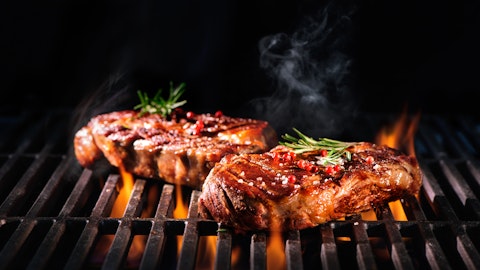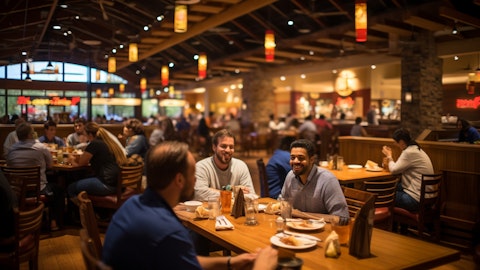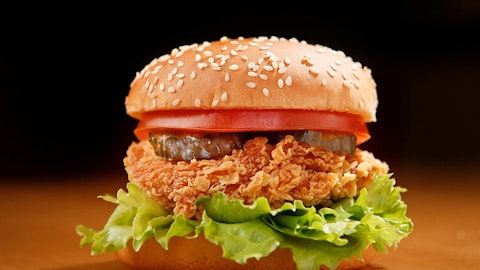Brinker International, Inc. (NYSE:EAT) Q2 2024 Earnings Call Transcript January 31, 2024
Brinker International, Inc. beats earnings expectations. Reported EPS is $0.99, expectations were $0.94. Brinker International, Inc. isn’t one of the 30 most popular stocks among hedge funds at the end of the third quarter (see the details here).
Operator: Good day, and welcome to the Brinker International Earnings Call Q2 FY ‘24. [Operator Instructions] It is now my pleasure to turn the floor over to your host, Mika Ware, Vice President of Finance and Investor Relations. Ma’am, the floor is yours.
Mika Ware: Thank you, Holly, and good morning everyone, and thank you for joining us on today’s call. Here with me today, are Kevin Hochman, our Chief Executive Officer and President; and Joe Taylor, our Chief Financial Officer. Results for our second quarter were released earlier this morning and are available on our website at brinker.com. As we always do, Kevin and Joe will first make prepared comments related to our strategic initiatives and operating performance. Then we will open the call for your questions. Before beginning our comments, I would like to remind everyone of our safe harbor regarding forward-looking statements. During our call, management may discuss certain items which are not based entirely on historical facts.
Any such items should be considered forward-looking statements with the meaning of the Private Securities Litigation Reform Act of 1995. All such statements are subject to risk and uncertainties, which could cause actual results to differ from those anticipated. Such risk and uncertainties include factors more completely described in this morning’s press release in the company’s filings with the SEC. And of course, on the call, we may refer to certain non-GAAP financial measures that management uses in its review of the business and believes will provide insight into the company’s ongoing operations. And with that said, I will turn the call over to Kevin.
Kevin Hochman: Thanks, Mika. Good morning everyone, and thank you for joining us as we shared continued progress against our long-term strategy Q2 marked another quarter of year-over-year improvement in the business. We delivered strong financial results while continuing to grow share during the quarter with Chili’s, beating industry sales by 4% and traffic by 2%. It’s another data point that gives us confidence. The strategic choices we have made to accelerate the business profitably are working. Our advertising strategy is driving guests in and the improvements we’re making to the guest and team member experiences are bringing guests back. While we are still in the early innings of these strategic shifts, we’re pleased with the progress, both in terms of the direction and the consistency of results.
Now let’s start with the improvements to the guest experience, where our operations teams continue to make steady and sustained improvement. The simplification efforts as well as the changes to the labor model are working. Guests are telling us the food is more delicious and more consistent. The service is more attentive, and our restaurants are more welcoming, which is leading the better overall experience and higher intent return scores. The main KPI, our organization looks at on a daily basis to understand guests experience is guests with a problem. When we started this journey almost two years ago, more than 5% of our dining guests reported problems with their experience. Now this number is down to 3.6%, which is a record low for our brand, since we began tracking the metric.
The work that our Chief Operating Officer, Doug Comings, and his field teams are leading is working to deliver sustainable improvements in the guest experience. Now, let’s talk about the progress we’re making with the team member experience. We know a better guest and team member experience starts with more stable management teams, and we continue to make great progress there. Our 12-month turnover improved another two points to 22% during the second quarter, accelerating our outperformance on retention versus the industry, which puts us at the very top echelon of restaurants. We think three things are driving this improvement in managerial turnover. First, the continued rollout of manager’s ideas on how to improve the team member and guest experience has them more engaged.
Second, those changes are in fact making their jobs easier to make guests and team members feel special. And third, the sustained improvement in sales is making their jobs more rewarding with higher total compensation. Our managers are telling us their quality of life has significantly improved, and in turn, they’re able to execute more consistently and focus on strengthening restaurant culture, which is leading to a better experience for their teams and their guests. As a result, we’re also now starting to make real inroads on hourly turnover, which improved again this quarter. Hourly turnover has been our operator’s obsession metric this fiscal year, and their focus on hourly training and simplifying jobs has made a material impact on this KPI for the front half of our fiscal year.
Now, we still have upside to be in that upper echelon of restaurants on hourly turnover like we already are on managerial turnover. But based on the team member initiatives being worked on, I’m confident we’ll make even more progress on the KPI in the back half of this fiscal. Now, I’d like to talk a little bit about advertising and the positive impact it is having on our traffic. Our advertising focus is on our unbeatable 3 for Me value platform, and that’s resonating with the consumer. A high quality complete meal at a great value is winning with guests. And when we turn this messaging on, we are seeing noticeable lifts in traffic, both versus our own runways as well as versus the industry. We are encouraged to see the campaign starting to build our longer term KPIs too.
Chili’s unaided awareness, which is the ability for a consumer to recall the brand without the prompt of advertising, has increased 9% over the past year. So what’s next in advertising? Testing new ways to talk about our offerings, as well as bring new food news to the 3 for Me platform to keep that messaging fresh for our customers. Lastly, we’re encouraged by how the improved dining experiences working in conjunction with the marketing. Compared to last year, when we were back on air, we are now seeing more sustained business lifts post the advertising bursts. We drove positive traffic in October, while we were on TV, and we continued to beat the industry in traffic for the remainder of the quarter. While we continue to improve overall traffic trends, we did see lower mix than prior quarters.
Some of this was expected as we laughed to October 22 — 2022, menu changes that reduced the number of 3 for Me, offers of the unexpected mix decline most of that was self-inflicted. The good news is we now know and understand the whys and changes are underway to reverse some of the impacts that we’ve seen on mix. There are two key factors contributing to lower mix. The first is menu merchandising. Our strategy to merchandise wings in quesadillas as appetizers on our August menu effectively significantly drove those items. We believe that strategy would drive significant incrementality through attachment, but it drove more trade down than we expected because some guests order these items as their entrees. We dropped a new menu yesterday that we believe will help reverse some of this negative mix trend.

We adjusted the menu merchandising to de-emphasize these items and included additional opportunities for trade up. The other factor that impacted mixed during the quarter was our decision to stay with 3 for Me messaging, which is clearly resonating in driving incremental traffic. But we did see a lower level of add-ons, alcohol and trade up versus previous advertising waves indicating we may be seeing a more conservative consumer. We expect maintaining leadership value on air will continue to drive Chili’s growing sales and traffic share, but we might see some softening and mix given where the consumer is. Now, let’s talk about Maggiano’s. I want to congratulate the Maggiano’s team for a strong holiday. In Q2, they delivered 6.7% sales growth, which was 4% better than the industry, coupled with an impressive 300 basis point improvement in margins.
We continue to be pleased with the strength of Maggiano’s business, and I’m very excited to welcome our new Maggiano’s president, who I believe is the perfect leader to accelerate the brand’s Dine-in off-premise and banquet growth. Dominique Bertolone is a highly respected food and beverage executive who spent more than 20 years with MGM Resorts International, progressing from leading highly regarded restaurants like — to serving as the Senior Vice President of Food and Beverage strategy for all of MGM, where he led more than 18,000 employees and drove more than $2 billion in sales. Dominique and the team are quickly working to develop a strategy to elevate the Maggiano’s experience, lean into the Maggiano’s differentiated brand, and improve the brand’s four wall economics, and ultimately accelerate Maggiano’s growth.
I look forward to sharing the team’s progress in the coming tours. In summary, we’ve had another solid quarter and progressing the strategy both in operational improvements and financial performance. Chili’s value message is driving trial. Our improving experiences is driving frequency, and we continue to drive innovation to keep our food and beverage platforms fresh. We feel good about the progression of our strategy and believe both our brands are well-positioned as we move through the back half of the fiscal year. Now, I’ll hand the call over to Joe to walk you through the quarter in more detail. Go ahead, Joe.
Joe Taylor: Thanks Kevin, and good morning everyone. Second quarter operating results reported this morning represent a very solid quarter of continued growth in the business driven by higher top-line sales and improved margins. We have previously indicated our strategy is designed to meaningfully improve the traffic dynamics of our brands through a better guest experience and effective marketing efforts. Additionally, we are looking to steadily improve margins while making the necessary operating investments into the restaurants to support sustainable growth. Our strong performance in the second quarter is good indication. We are making progress in all these key areas. As to specific results, for the second quarter of fiscal year ‘24, Brinker reported total revenues of $1,074 billion, up 5.4% from prior year, an improved restaurant operating margin of 13.1%, and adjusted diluted earnings of $0.99 per share, a 30% increase versus prior year.
At the brand level, Chili’s post comp, store sales of 5% for the quarter, while Maggiano’s recorded a comp sales gain of 6.7%, both brands nicely hurdled strong quarters from the prior year. While overall comp sales met our expectations for the quarter, the component makeup of the sales did take on a different stack. While price was as expected, we did experienced higher traffic and lower mix versus our expectations. Chili’s reported traffic of negative 0.6%. We are still experiencing the year-over-year impact of the planned de-emphasis of virtual brands, including the discontinuation of Maggiano’s Italian Classics and materially reduced promotional activity for It’s Just Wings. In the second quarter, reduced virtual brand activity negatively impacted Chili’s traffic by approximately 2.5%.
Excluding the traffic decline from virtual brands, Chili’s base business traffic for the quarter was a positive 1.9%, a great indication the traffic-driving aspects of our strategy are resonating and attracting many new guests. Maggiano’s also delivered a solid second quarter, fueled by a strong holiday season. The brand reported positive sales of 6.7%, driven by 10.5% price, 0.4% mix, partially offset by negative 4.2% traffic. Overall, the Maggiano’s business is moving in the right direction, with positive traffic in dining rooms and banquets, the two most profitable channels of the model. Now turning to our strengthening restaurant margins. Our restaurant operating margin for the second quarter was 13.1%, an increase 150 basis points year-over-year.
Sales leverage from top-line growth, cost of sales moderation and effective cost management by our operators were the primary factors driving the improvement. We are particularly encouraged by our strengthening margins in the context of also being able to make meaningful operating investments in the important areas of labor, R&M and marketing. These levels of investment will help to build and sustain our business model, as we move forward. I would mention a couple of underlying specifics within the various areas of restaurant level margin. Food and beverage costs were materially improved from the prior year, notably in key areas, such as poultry, ground beef and oils. From a labor perspective, we continue to experienced wage rate gains in the mid-single-digit range in addition to the hours we invested into the labor model.
And restaurant expense was impacted by the investments in marketing and repair and maintenance expense beyond the benefit from sales leverage and cost-effective management and other expense lines. Improved restaurant and operating margin supported growth in our quarterly EBITDA, with this important earnings measure reaching $107 million, an 18% increase from the second quarter of last fiscal year. The improved operating performance also led to incremental capital deployment in key areas of our capital allocation strategy. During the quarter, Chili’s completed and opened five new restaurants, all of which are off to excellent starts. Approximately $31 million were invested into our existing fleet in the form of R&M and re-image work. Importantly, we repaid $39 million of outstanding revolving credit borrowings as part of our ongoing efforts to strengthen the balance sheet and lower leverage ratios.
Our total debt-to-EBITDA ratio reduced to 2.1x at quarter end. In this morning’s press release, we updated two key pieces of our annual guidance. Brinker’s annual total revenues for the current fiscal year are now expected to be in the range of $4.3 billion to $4.35 billion. Our adjusted earnings per share is now expected to be in the range of $3.45 to $3.70. Our existing guidance for weighted average shares and annual capital expenditures were also reiterated. While we don’t provide specific quarterly guidance, I would comment that the January period we are ending today has experienced particularly tough and continuous weather issues across a broad swath of the country. Our updated guidance does include an estimate of the negative impacts from the January weather, with the understanding that third quarter results will be particularly impacted by the tough start to the quarter.
Apart from the weather impact, we continue to believe the critical drivers of our improving performance remain intact. We now move into the second half of our fiscal year. We remain committed to the strategies that are positively impacting the performance of our brands. Guests are responding to the improved experience they receive in the restaurants. Our marketing presence is breaking through in highly effective ways, and our key investments, both from an operational and capital perspective, are coming together to enhance the sustainability of our efforts. We look forward to continuing to highlight our progress in the coming quarters. And with our comments now complete, let me turn the call back over to Holly to moderate our Q&A.
See also 11 Highest Quality Caviars in the World and 13 Best Aerospace Stocks To Buy On Sale.
Q&A Session
Follow Brinker International Inc (NYSE:EAT)
Follow Brinker International Inc (NYSE:EAT)
Receive real-time insider trading and news alerts
Operator: [Operator Instructions] Your first question for today is coming from Jeff Farmer with Gordon Haskett.
Jeff Farmer: You mentioned weather, but any other drivers you can point to for the weaker January sector traffic trends?
Joe Taylor : No, Jeff, this is Joe, and good morning. We think weather is the biggest delta going into the weather. We were seeing results that were really meeting our expectations. So again, what was driving the business coming out to the quarter seemed to have carried over into January. The biggest deltas and the — it’s a murky situation with the amount of weather that extended over really three and a half weeks. But again, as I said, I think the drivers are still pretty much intact. The weather impact is probably going to really be in the $10 million to $12 million range for that quarter. It’s a pretty significant because of the extent in the range that the weather impacted across the country.
Kevin Hochman: Yeah, I mean, the other thing that we look at, Jeff, just so — is Kevin, we look at how we’re doing versus the industry given the industry also has the same weather. We look across a swath of different concepts and it looks like the gains that we saw in Q2, they’re not changing. So we feel like, at least from a relative performance standpoint, it really is the weather versus anything that’s happened in our business.
Jeff Farmer : And just one more you guys did touch on it, but could you just provide a little bit more color on the customer or consumer response to that fourth flight of TV, or national TV in January, relative to what you saw with the first three flights? Is the consumer still responding sort of as aggressively as they were early on?
Kevin Hochman: Well, it’s always tough to tease that out when you have the weather that we had in January. What I can tell you is we continue to see that expansion on both sales and traffic versus the industry, which would lead us to believe it having similar impacts. Obviously, you are not going to see the same burst that you saw in Q2, given what happened with the weather, right? But in terms of relative performance versus the industry, we have been very pleased with the advertising.
Operator: Your next question is coming from Brian Vaccaro with Raymond James.
Brian Vaccaro: Just on back to the fiscal second quarter comps, and I wanted to dial in on the mix a little bit if we could. Could you provide more color on what the mix of the 3 for Me platform was in the quarter compared to last? And are you seeing a higher preference for the $10.99 price tier versus higher tiers?
Kevin Hochman: I’ll start off and then Mika can give you a little bit more granularity. So we saw about, we keep quoting the percentage of checks on deal and that had been going down steadily and then it kind of flattened out over the last couple of quarters. We did see that tick up about two points. So the percentage of checks on deal went up from 29% the previous quarter to 31% this quarter. So we are seeing a little bit of a tick up there. And then within the tiers of 3 for Me, we are seeing a little bit more preference on 10.99%, but it still is the minority of the checks that are purchased or 3 for Me are still at the $14.99 and $16.99 here. So to answer your question very directly, Brian, it’s like two points more saw on checks on deal and then a slight more preference to $10.99, but not anything really significant.
Brian Vaccaro: Okay, great. Thank you for that. Go ahead, Mika.
Mika Ware: Yes. And just a detail on that. So our preference, we’ve always said, it always runs in that mid-teens. It was because of the success of the second quarter, we did see it tick up to probably from about 14% to 15%. So we did have a little tick up there.
Brian Vaccaro: And then I guess as it relates to, Joe, there was a question about January and the weather, and it sounds like you are confident that, it was weather that disrupted things. So is it reasonable to assume you have seen some improvement, as the weather has warmed up in certain pockets of the country here in the last week or so?
Joe Taylor: Yes. As you come out of the big weather swaths, this last really five, six days, we have definitely seen a reversion back to some of the way the performance is looking prior to the weather. That gives some comfort. Again, we want to be cognizant and watch the consumer closely coming out of the holidays. We will continue to do that as we move through see quarter. There is a feeling of a little bit more conservatism in the consumer, but still have plenty of dollars out there to be captured. And when we see those gaps to the industry continue to grow and we think again that value on your consumer is gravitating our direction.
Brian Vaccaro: And then just one more on advertising, if I could. In January, I believe the plan as you had laid it out was to run four weeks. I was curious if you altered that plan or adjusted weight in any way or maybe it was too late to do that as the weather set in? And then could you also just talk about the TV plan for the rest of the fiscal year? Any changes versus what you previously communicated?
Joe Taylor: I can share the insight on that. Yes, certainly, when you are talking about TV, it’s much harder to get out of that quickly. When you see the weather that’s coming, certainly, you can tail it back a little bit of digital, but the bulk of the spend is unable to pivot out. That obviously would have been the thing to do if you had that kind of freedom. Going forward, we have about 11 weeks remaining in the advertising. So remember, we talked about 27 weeks for the total fiscal year. We have 11 weeks that we have not spent yet. The bulk of that will be in the months of March and May. And none of this has changed our plans. We feel very confident about where we are. That’s why we had the guidance that we gave. And we feel like we’re going to continue to make investments into the business to continue to accelerate what we’re seeing in traffic and sales.




